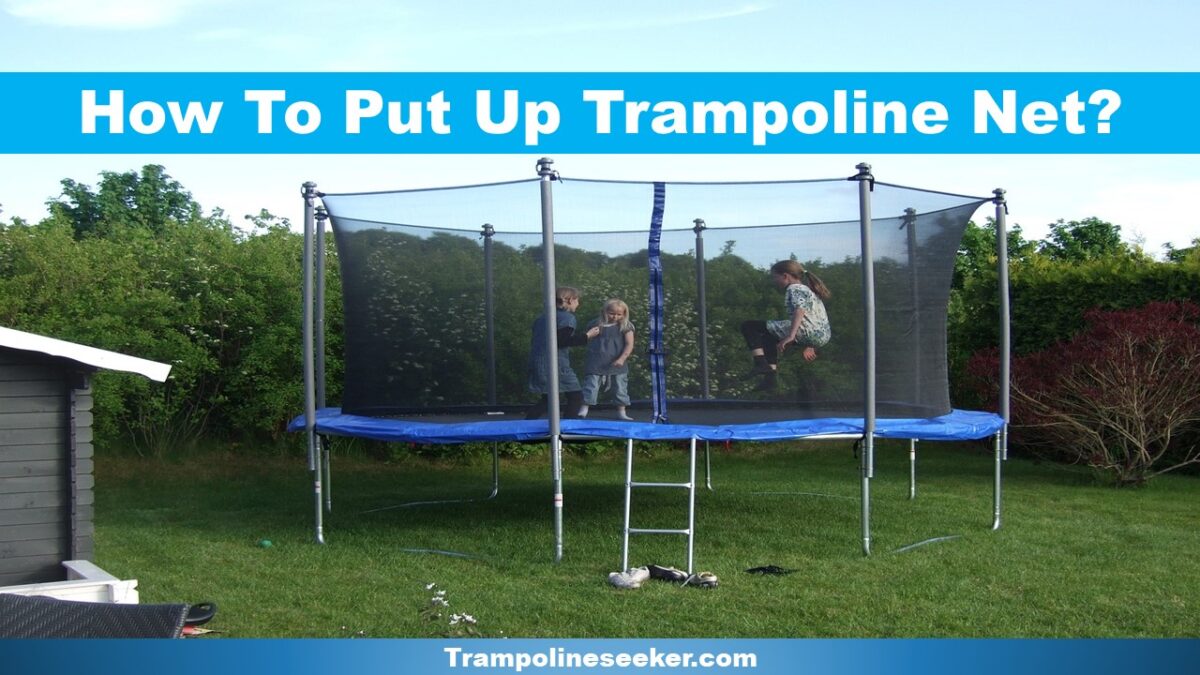Trampolines are always so much fun! As a parent, I want my kids to be able to bounce safely. That’s why I looked into whether trampoline nets are universal – can I use any net with my trampoline frame? Here’s what I discovered.
A Quick Answer on Trampoline Net Universality
The short answer is – it depends! 😄 Some trampoline nets are designed as “universal” to fit multiple brands and sizes of trampolines. However, trampoline nets are often specific to the size and shape of the trampoline. You can’t use a net made for a 15ft round trampoline on a 10ft x 17ft rectangular one! But many round trampoline nets will state they’re compatible with various brands and pole counts if the size matches.
Trampoline nets, like those from Machrus Upper Bounce and Upper Bounce, are designed to fit various trampoline brands, offering a universal solution for different frame sizes.
Note: These nets are okay, but they don’t match the quality you get from original ones.
I’ll go over all the details throughout this article! The key is ensuring you get a trampoline net made for your specific trampoline’s shape and dimensions. Let’s bounce into the specifics…
My Experience Shopping for Trampoline Nets
As a busy parent of three energetic kids, I know how important it is to have a safe place for them to play in our backyard. That’s why we invested in a nice big round trampoline a few years ago. The kids have loved it!
But as they’ve gotten older (and wilder!), I started worrying about them bouncing right off the edge. I decided it was time to get a safety net enclosure. I started researching different brands and options online.
At first, I just assumed I could buy any net as long as it was for a 15ft round trampoline. But looking closer at product listings, I realized all nets are NOT universally compatible. I had to pay attention to pole count, shape, brand, and exact sizing if I wanted a perfect fit.
While confusing at first, it makes sense that trampoline net enclosures are often specialized for specific models. A tight, secure fit is important for safety. Loose netting can cause gaps and tripping hazards.
After carefully measuring our trampoline and double checking the specs, I ordered a net designed specifically for our make and model. I’m happy to report it installed easily and now gives me peace of mind. The kids have years of safe bouncing ahead!
Factors That Determine Trampoline Net Universality
If you’re also shopping for a new trampoline safety enclosure, make sure to keep these key factors in mind:
Size and Shape
The most important compatibility factor is the size and shape of your trampoline mat. Trampoline nets are available for round, square, rectangular, and oval trampolines.
Common round sizes are 10ft, 12ft, 14ft, and 15ft. Rectangular trampolines for backyard use are often 10x14ft or 10x17ft. Larger rectangular trampolines may be used for athletic training.
Make sure to measure your jump mat width and length. Then get a net made for that specific size and shape. A 15ft round net won’t properly attach to a 14x10ft rectangular trampoline.
Pole Type and Pole Count
On round trampolines, the net connects to vertical poles around the edge. The number and placement of poles provides stability and structural support.
Some round trampoline nets are “universal” and made to fit various pole counts – for example, a net may fit 6 to 8 pole trampolines. Other nets are tailored to specific pole numbers like 6 or 8.
If your round trampoline has an arched pole enclosure, look for a net designed for that type. The net will attach differently, looping over the arched tops.
For square or rectangular trampolines, vertical poles are placed in each corner. Then a horizontal bar may connect the tops of the poles along each side. Nets are made to fit the pole and bar configuration.
Brand and Model
While some trampoline nets advertise universal fit, others are made exclusively for a specific brand and model.
For example, SkyBound, Springfree, Avyna, JumpSport, Upper Bounce, and other brands make nets custom-tailored for their trampolines. The net ties or buckles into specific spots on the mat edge and poles.
So while that SkyBound net may fit the right size oval trampoline, it won’t align perfectly on an Upper Bounce oval of the same dimensions. For best safety and appearance, get a net designed for your exact trampoline brand and model.
How Trampoline Safety Nets Work
Now that you know about finding the right net for your trampoline shape, size, and brand – let’s look at how trampoline safety enclosures work! 👀
Trampoline nets provide a barrier around the jumping surface to prevent falls and injuries. They attach to the trampoline frame and mat edge. Quality nets are made from durable UV-resistant materials like polyethylene or vinyl-coated polyester.
Net Attachment
For round trampolines, vertical poles around the edge support the net. Straps on the net loop over or buckle around the poles. The bottom edge of the net attaches with a rope or bungee that ties to the trampoline frame or springs.
On rectangular trampolines, horizontal bars connect the upright poles on each side. The net ties to the poles and stretches across attaching to the opposite poles. Again, the bottom edge attaches to the frame.
No matter the shape, the net remains suspended above and around the bouncing mat. Jumpers can’t accidently soar off the trampoline, but gaps aren’t created where little hands and feet can get caught.
Entry Opening
Trampoline nets completely surround the mat, except for an opening which allows you to climb in.
The entryway may have overlapping flaps held together with velcro, zippers, or buckles. Some use magnets or toggles to keep the entry overlap secured.
Make sure to always completely close the entry opening when kids are bouncing! Check for proper closure every time.
Height Clearance
Safety nets extend above the trampoline mat at least 6 feet tall (sometimes as high as 8-10 feet). This prevents jumpers from flinging upward out of the enclosure. Nets often have extra tall clearance around the entry opening.
The net shouldn’t be so high that it sags, though. Any slacking can lead to trapped body parts or tripping. Measure your mat height and buy a net made for that elevation.
Trampoline Safety Net Benefits
Trampoline nets provide major safety benefits and peace of mind. Here are the key advantages trampoline enclosures offer:
Prevent Falls
The obvious benefit is keeping jumpers safely contained inside the netted area! Trampoline injuries most often occur when a child bounces off the mat edge and lands on the ground or frame. Nets eliminate this hazard.
Prevent Impact With Structures
Trampolines should have clear open space all around them. But backyard play areas are often tight. An enclosure net prevents bouncers from accidentally hitting a nearby fence, tree, or toy structure.
No more tumbling into the bushes for an added dose of scrapes and bruises!
Focus Jumping Inward
Nets encourage jumpers to concentrate their bouncing straight up and down. Otherwise, they may get tempted to see how close they can get to the edge. A net barrier curbs risky, distracted jumping habits.
Keep Pets Out
Pets and trampolines don’t mix! A fully enclosed trampoline net keeps dogs and cats off the mat while kids are jumping. No more adorable interruptions or safety concerns.
Limit Access
Trampolines draw irresistible appeal from neighborhood kids! A net enclosure provides a visual cue marking off the trampoline as “in use and occupied”. It’s easier to control access, so you always know who’s bouncing.
Installing Your Trampoline Safety Enclosure
When your trampoline safety net arrives, make sure to spend time properly installing it. Rushing through this critical step can severely impact safety and function.
Carefully follow the net manufacturer’s instructions. The process typically involves:
- Attaching the net straps or ties to the trampoline frame, one section at a time. This takes patience to evenly distribute the net.
- Making sure the bottom edge of the net is firmly affixed all around to the trampoline frame or springs. This prevents gaps where jumpers could slip underneath.
- Checking that entry flaps fully overlap and all closure systems work smoothly but securely.
- Confirming there are no gaps or loose areas on the net. All straps and attachment points should be taut.
- Watching a jumper test it out and readjusting any problem spots.
- Checking on the net integrity periodically and re-securing any loosened areas.
Taking care during trampoline net installation goes a long way toward ongoing safety and enjoyment!
Maintaining and Replacing Your Trampoline Net
With proper care, a quality trampoline safety enclosure should last many years. Follow these tips to extend your net’s lifespan:
- Check for holes, tears, fraying, and deterioration in the netting. Catching damage early makes repairs easier.
- Use UV-protectant spray to extend the net’s resistance to sun damage.
- Keep an eye on straps and attachment points, re-securing any loose spots.
- Avoid letting jumpers hang from or pull aggressively on the net.
- Take down the net in extreme winds to prevent whipping that can cause tears.
- Replace the net once it shows extensive wear and deterioration. Gradual weakening can lead to failure.
While trampoline nets are durable, they do need periodic replacement. Review the manufacturer’s recommendations for maximum lifespan. Many recommend replacing the net every 2-3 years.
Trampoline Safety Starts With You!
While nets add a key layer of protection, active adult supervision is still essential for safe trampoline play. Keep these guidelines in mind:
- Limit jumpers to one at a time. Collisions can cause injuries.
- Enforce rules and safe jumping habits. No somersaults or flips, stay in the center of the mat, take turns, etc.
- Make sure jumpers are barefoot to improve grip and control.
- Monitor for tiredness, giving frequent breaks. Fatigue leads to accidents.
- Keep an eye on smaller kids and spot them if needed.
Stay alert and actively engaged whenever the trampoline is in use. Your oversight helps prevent injuries and ensures fun for all!
Let the Safe Bouncing Begin!
I hope this overview clarifies that trampoline nets are made to fit specific sizes and brands. While some advertise universal fit, taking exact measurements of your trampoline and finding a net specially made for it is the safest route.
Adding a quality trampoline enclosure takes jumping fun from risky to responsibility-free! As kids burn energy bouncing safely, parents can relax and join in worry-free.
With a designated trampoline area in the backyard, I know my kids will be active and entertained through many sunny childhood summers. Now excuse me while I go work on my backward somersault…💪
FAQs About Trampoline Net Safety
Are trampoline nets really necessary for safety?
Trampoline nets provide a key layer of protection against common injuries from falls and collisions. While adult supervision is still crucial, nets greatly minimize risks.
Can you put a net on any size or shape trampoline?
Nets must be matched to the specific trampoline size and shape. A net designed for 14ft round won’t fit a 12x15ft oval trampoline. Measure carefully before buying.
How do I know which trampoline brand a net will fit?
Read net descriptions carefully to see sizing and brand compatibility details. Some are universal but others are tailor-made to fit specific brands/models. Match your trampoline brand and dimensions.
How long should my trampoline net last?
With proper care and maintenance, a high-quality trampoline net should last around 2-3 years before needing replacement. Check for wear, damage, and deterioration regularly.
How do I know if my trampoline net needs replacing?
Look for stretched out or sagging netting, holes/tears/frays, broken straps, damaged fasteners, worn entry flaps, and signs of UV damage. If the net looks weakened, replace it even if not torn.
Articles You May Like to Read:













